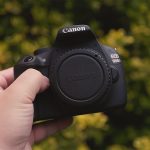In this review, we’re going to have a look at the Canon EOS 6D. I’m going to show you what it can do, what it can’t do, and whether it’s a great fit for you.

Size & Build
They released this camera all the way back in September of 2012. Despite being designed as an entry-level full-frame DSLR, it actually feels quite nice in the hand.
They made the frame from aluminium alloy and the coating from polycarbonate resin. In fact, they supposedly sealed this camera against splashes, but we’ll discuss that later in this review.
When it comes to its physical size, it measures 144mm x 110.5 x 74.8mm, and it weighs in at around 765 grams, which makes this a relatively beefy camera.
I actually like that, as I’m a fan of larger cameras, including my main camera, which is a Canon R5. With that in mind, I know most people prefer smaller cameras, so I thought you might want to know about its size.
By the way, if you want to check out some smaller cameras, I have a playlist on my YouTube channel, where you can see more of my Canon camera reviews.
Now that we’ve covered the physical aspect of this DSLR, let’s have a look at what it can do visually, and answer the most important question: Can this 10-year-old camera produce good images?

Image Quality
Well, I’ll show you some photos I’ve taken with this camera in a bit, but first, let’s talk about its specs. It has a 20.2 MP Full Frame CMOS Sensor.
What does that mean in practice?
Sensor
So, most affordable Canon cameras will have cropped sensors, or APS-C sensors, which usually measure around 22.3mm × 14.9mm. On the other hand, the 6D has a full-size sensor, measuring 35.8mm x 23.8mm. If 35mm sounds familiar, it’s because a full-frame sensor mimics old 35mm film.
One advantage that full-frame sensors have over cropped sensors is that they can take in more light. If you have two cameras that are very similar, with the same settings, and the same lens, the camera with a full-frame sensor will produce a brighter image.
This is fantastic news if you’re looking to shoot in low-light conditions.
Additionally, you don’t get the 1.6x crop which cropped sensors have. If you mount a 50mm lens on a full-frame camera, you’re shooting at 50mm. If you mount it on a cropped sensor camera, like the Canon 77D for example, you’re really shooting at 50mm x 1.6, which is 80mm.
Bear in mind that, in practice, full-frame sensors aren’t necessarily better than cropped sensors. Most photographers have their preferences, some opting for full frame, and some opting for APS-C cropped sensors, as they each give a slightly different look.
Processor
In terms of processor, the Canon EOS 6D has the DIGIC 5+ model, which is quite out of date by this point, but which can still do a decent job. The DIGIC 5 actually introduced better noise reduction, so if you’re taking photos in low light, at least in theory, the DIGIC 5+ processor should help with that.
In short, the processor acts like the ‘brain’ of the camera, being involved in everything from image processing to autofocus.
What do I mean by image processing?
Well, in older analogue cameras, light passed through the lens and projected onto a light-sensitive film, which then ‘captured’ the image. With digital processors, the light travels through the lens, hits the CMOS sensor, and then the processor takes all that light information, and transforms it into a digital file.
Autofocus
Speaking of focus, how good is the auto focus on this camera?
Well, you have 11 AF points, which is better than a lot of entry-level cameras, but it’s not great by today’s standard. For reference, the Canon 77D, which was released in February of 2017, has 45 AF points. My Canon R5, has 5940 AF points.
Yeah. Quite the difference, eh? Oh, you also don’t have Canon Dual Pixel AF, which is a shame. That didn’t come out until a few years after this camera was released.
Now, do not be dismayed by this. There is actually a great benefit to having an older camera that can’t do quite as much, and I’ll go into detail about that in a bit, once I’ve shown you some photos first.
Before we do get to the photos, there are a couple more specs to cover.
ISO
First off, ISO. For this camera, the ISO range is from 100 to 25600, and it can expand all the way to 102800. You can think of ISO almost like a brightening slider. It’ll make the image brighter, but it will also introduce unwanted noise, so use this feature sparingly.
Also, if you’re looking to capture sports, or wildlife, this camera can do 4.5 fps in continuous shooting mode. Its shutter speed is also up to 1/4000s, which will allow you to easily freeze motion.
Now that we’ve covered what the camera can do, it’s time to show you some pretty pictures. First, I’ll show you some photos I took at a Zoo in Porto, Portugal, when I visited.
Let me know which one was your favourite.


Video
Now that we’ve seen what this camera can do photographically, let’s talk about video, and then we’ll address why this camera is great if you’re a beginner, or even an intermediate photographer.
So, when it comes to video, the camera can do 1080p @ 30fps, which is not surprising given the age of the camera. 1080p @ 60fps wasn’t introduced until 2013, with the DIGIC 6.
So, yeah, it can shoot video, though it won’t look fantastic. It does depend on what you’re filming, how much light you have available, the speed at which the subject is moving, and more.
Does the camera at least have in-body image stabilisation? Nope. You don’t get that either.
Ok, so this camera doesn’t produce fantastic video. Is there any point in buying it then?
Yes, there is. Allow me to go into a bit more detail on this.
Applications
You see, when it comes to video, this camera is clearly quite dated. If you have a relatively recent iPhone, like an 11 or newer, it’ll very likely have much better autofocus and perhaps even dynamic range.
What modern smartphones don’t have, is a large sensor, like the 6D, the capacity to use different lenses, and the ability to easily change settings on the fly. Even though a new iPhone would definitely do a better job of exposing a scene in auto mode, the 6D’s manual controls allow you to manually expose the scenes yourself, with far greater ease.
The kind of lenses that you can use on the 6D will also produce different results, allowing you to capture subjects at great distances, shoot portraits with beautiful blurry backgrounds, and more.
The size of the 6D sensor will also allow in more light, thus producing cleaner images. Even when it comes to video, technically a newer iPhone can beat the 6D, but if used right, the 6D will outperform the iPhone 99 times out of 100, if you know what you’re doing.
And this is the key phrase right here: ‘If you know what you’re doing’. This, right here, is why this camera is great for beginners and even intermediate photographers.
The Challenge
Because this camera is technologically outdated, it will force you to improve your photography skills through its sheer limitations. Is the exposure in Auto mode absolutely terrible? Better switch to Manual mode, and learn how to balance aperture, shutter speed, and ISO.
Is the autofocus spotty? Time to switch to manual focus, and practice.
Is there too much, or not enough light in the scene? Time to learn how to introduce, or remove light, in order to achieve the look that you’re searching for.
See what I mean? Using something that is relatively outdated will force you to be creative, and this will make you a much better photographer in the long run. This is the benefit of older cameras.
By the way, if you want to learn more about the kind of lenses that the 6D can use, I’ve reviewed a few on my YouTube channel. This is also true for iPhone reviews, as I’ve covered both the iPhone 12 Pro Max, and 13 Pro Max.
Vlogging
Alright, so since we brought up smartphones, is this camera any good for vlogging?
Well, technically. Even though this camera doesn’t have a swivel screen, you can technically use it for vlogging. In fact, it’s better than a lot of other entry-level cameras at that, due to its full-frame sensor.
On other affordable cameras, you’ll usually have a cropped sensor, which means that the image is more zoomed in. Not on a full-frame sensor though. On this camera, you’ll have more options when it comes to lenses, as when you turn the camera around, and hold it in your hand to vlog, more of you will be in frame.
You can also use something like a Gorillapod to extend your reach, and get even more of yourself into frame.
YouTubers
How about if you want to use it to film videos for YouTube, or online content in general?
Yup, it would work, but again, when it comes to video, I’d use the 6D more as a learning camera, than anything else. The video won’t be amazing, unless you really know what you’re doing. If you want to film online content, you’re better off looking at a slightly newer camera, like the Canon 77D, or even just using your smartphone.
If you do absolutely want to use this camera for video, it might be best to grab a tripod. Since you won’t be moving around, you can use a more zoomed-in lens, like the Canon 50mm f1.8, or f1.4, and thus you can get some really nice blurry backgrounds.
The AF system on the camera might struggle to get you in focus at times though, if you’re at f/1.4 or even f/1.8, so do bear that in mind.
Compatible lenses
What about compatible lenses? The 6D can take EF lenses, which leaves you with a basically inexhaustible list. I’m not going to go into every EF lens in this article, but I do have a playlist with EF lenses which I’ve reviewed.
You can either check the playlist on my YouTube channel.
Quick Note: It’s important to bear in mind that EF-S lenses will not fit on this camera. Some of the more affordable lenses fall in this category, like the kit 18-55mm lenses, or the 24mm f/2.8 ‘Pancake’ lens.
Display
Next up, what’s the 6D like in terms of screens? On the back, you’ll find a 3″ display, which won’t wow anyone, but which will do the job. On the top of the camera, you’ll also find a tiny display, which I actually love.
You don’t technically need it, and some photographers don’t use it at all, but it’s great if you want to quickly check your settings. I personally love the little display at the top of Canon DSLRs.
Control
In terms of control, there’s nothing special going on. You have a few basic buttons for menus and such, a few more buttons above the small top LCD screen, and a control wheel, to navigate menus, and scroll through your photos.
Nothing too extravagant.
Storage
What about storage?
The EOS 6D, much like many other entry-level cameras, even full-frame ones, only has one SD card slot. This isn’t a problem, as I see the 6D as more of a ‘learning camera’ at this point. Since you’re unlikely to do professional gigs with it, one SD card slot is fine.
The reason why I’m bringing this up is that, with any SD card, there’s always a very small risk of the data on it becoming corrupted. If you’re just using the camera for fun, or to learn, this isn’t such a big problem, but it can quickly turn into one if you’re doing professional gigs.
It’s important to bear in mind that I’ve done professional gigs with cameras that only had one SD card, and I’ve never had any SD card become corrupt, but I also have very good backup habits, during, and after each gig.
Battery Life
How about battery life?
The Canon 6D uses the LP-E6 battery, which is the same as on the 5D Mark III, 5D Mark II, and the 7D. You can expect around 1000 photos from a new battery, though since you’ll be buying yours second-hand, you should probably expect fewer.
It’s always good to have a couple of spares with you anyway.
Longevity
Now, when it comes to longevity, what can you expect from this camera?
Its construction provides some protection from dust and moisture, even though it’s not weather-sealed. I always take care with my cameras, even if they are weather-sealed.
When it comes to the maximum number of actuations, the 6D sits at around 100,000. The maximum number of actuations is simply how many photos a camera can take before it, theoretically, fails.
When purchasing the camera, make sure to check with the seller what the current actuation number is. This is important to know, so that you can be aware of how much life the camera has left. If the seller says they don’t know, or they won’t tell you, move on.
Chances are the camera they’re trying to sell you has a high number of actuations already.

Conclusion
So now, finally, is the Canon 6D worth purchasing in late 2022, and beyond?
If you are a beginner, or even intermediate photographer, who’d like to graduate to a full-frame camera, is the EOS 6D worth it?
Absolutely. Despite its older specs, the ‘bones’ of the camera are still great. You can produce high-quality images, if you know how, and this is precisely why a camera like this is so good for beginners.
Given the lack of modern features, like AI focusing and such, you’ll be forced to actually get good at photography. Nothing like some good limitations to summon creative problem-solving.
However, if you want to use it for professional use, I’d say no. The AF can struggle at times, and video lacks Dual Pixel AF, which would be a problem with professional gigs.
If you’ve already learnt a bit about photography and videography, and you’d like to graduate to something more mid-range, feel free to have a look at the camera review playlists on my YouTube channel.
I’ve reviewed all sorts of cameras, from the Canon 77D and 7D mkII, to the Canon R, and Canon R5.
If you’d like to purchase any of the items I’ve mentioned in this video, or see how much they cost in your country, I have a link down below where you can view them.
Thank you for reading my review of the Canon 6D. This is all for today, I hope you found this article to be enjoyable, and I invite you to have a look at some of my other articles. We have something for everyone, whether you’re interested in audio, or cameras and lenses. Alternatively, if you prefer video reviews, feel free to have a look at my YouTube channel.
Product Links
Down below you will find all of the items I talked about in this article.



